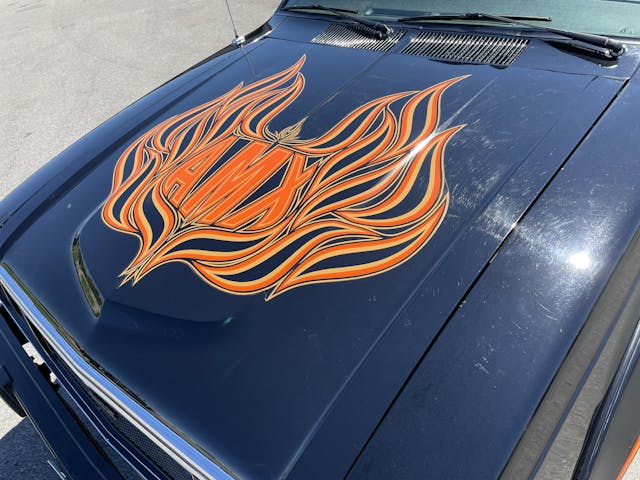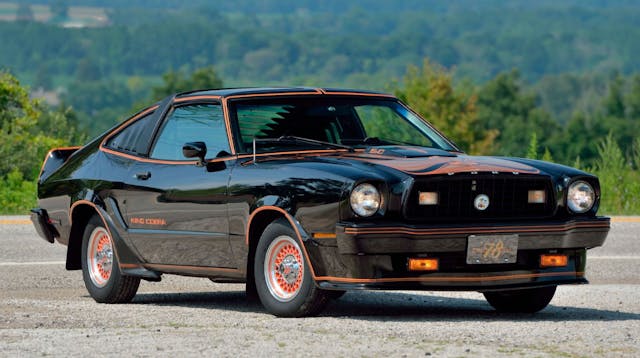Mustache Muscle: 6 climbing classics of the ’70s and ’80s
From a performance car enthusiast’s perspective, the mid-’70s and early-’80s didn’t have much going on. High-compression big blocks were a thing of the past, and burning rubber right off the showroom floor proved increasingly challenging. That didn’t keep American cars from looking the part, though. Despite the oil crisis, regulations, and insurance rates neutering cars for the better part of a decade, automakers didn’t stop building cars with all the appearances of being able to lay down long streaks of rubber at any impromptu stoplight drag race.
Gimmicks and graphics, decals and doodads ruled the day, and thanks to the facial hair fashions of the era, “mustache muscle” is the term we like to use.
Always attention-grabbing but rarely worth much money, mustache muscle has nevertheless gotten pulled up by the recent growth elsewhere in the classic car market. Several of them, including some of our favorites, have surprised us. Here they are.
1977–78 Ford Mustang II Cobra II/King Cobra

Ford’s OG pony spans six generations and counting, but the Mustang II is the one many people would rather forget. This compact, Pinto-based coupe didn’t even have a V-8 option when it debuted in 1974. Having gone from the likes of the Mach 1 and Boss 429 to this in just a few short years is as emblematic of American muscle’s quick demise as anything. To be fair, though, the Mustang II was the right car for the time, selling over a million units before the Fox-body came along in 1979.
Few Mustang IIs raced between stoplights, but there were at least a couple of peppy-looking V8 models to choose from. First came the Cobra II: available with either a V6 or 302/134hp V-8, it was, in the true spirit of mustache muscle, an appearance package. To trick people into thinking it was fast, the (fake) hood scoop, spoilers, quarter window louvers, stripes and Cobra graphics mimicked the original Shelby GT350 from the ’60s .
Next was the V-8-only King Cobra, introduced for the Mustang II’s final model year in 1978. The air dam, stripes, and a massive look-at-me Cobra decal on the hood aped Pontiac’s “screaming chicken” Trans Am styling cues, although it offered even less performance.
Nobody ever paid much attention to Mustang IIs as “classics,” but prices for the loud and proud Cobra models started to shoot up in late 2020—way up. Over the last three years, condition #2 (Excellent) values Cobra IIs with the six-cylinder engine are up 102 percent (to $19,600) and V8s are up 160 percent (to $30,700). King Cobras are up 110 percent (to $29,000). The most expensive ones we’ve seen were a ’76 Cobra II for $45,360 and a King Cobra for $36,300, both sold last year.
Quoted insurance values for Mustang IIs are up significantly as well over the same period and, surprisingly, they're popular with young car enthusiasts. These decal-driven pony cars date from Gen X's youth, but they're disproportionately more popular among Gen Z, who quotes 16 percent of Mustang IIs despite representing just 7 percent of the market.
1979–80 AMC Spirit AMX

Bearing little resemblance to the original '60s two-seat AMX or the baroque 1971-74 Javelin AMX, the Spirit-based AMX of 1970–80 was American Motors' last real go at a sporty car. AMC delivered on the era's expected tacked-on look-fast bits: the Spirit AMX sported a front air dam, rear spoiler, fender flares, side graphics, and a giant hood decal that looks like a temporary tattoo you'd buy from a vending machine. There were also some genuine driving enhancements: mild suspension modifications, quicker steering, and better brakes all gave the AMX better handling than the standard Spirit, and the eight-gauge dash, unique steering wheel, and bucket seats implied serious sporting intent. Press the accelerator, though, and you'd quickly discover the 125 lazy horses under the hood with the 304 cid V-8 (or 110 hp with the 258 cid six).

Despite the flame decal on the hood, the AMX didn't set any sales figures on fire. Just 3,600 Spirit AMXs left dealerships in 1979—Ford managed to sell over 10 times more Mustangs that year. Sadly, few Spirit AMXs have survived the ravages of time. One of them, likely the world's best, has been to auction several times over the last few years, selling for a then-staggering $24,200 at Spring Auburn in 2019, at Mecum Chattanooga last year for $31,350, and then for $35,750 in Kissimmee this January. That's the high-water mark, though. While these late AMX have gotten pricier in recent years, Hagerty Price Guide values still put condition #2 cars in the teens and #1 values at under $30,000.
1978–81 Chevrolet Camaro Z/28

1978 saw the third and final facelift for the second-generation Camaro, and top-mustache status in the lineup went to the Z/28. Adorned with fender louvers, hood scoop, spoilers, decals and optional T-tops, the Z/28 screamed for attention. A close-ratio M21 4-speed and dual exhaust attached to the tried and true 170-190-horsepower 350 V-8 did their best to provide some entertainment, if not outright speed.
Late second-gen Z prices have steadily increased over the last five years, but the most substantial bump has occurred in the last 18 months. Average condition #2 value for a 1978-81 Z/28 is up 79 percent since 2017 to $43,400 (about the cost of a brand-new, 455-hp Camaro 2SS), but driver-quality #3 cars can still be found in the mid- to high-$20,000 range. A fixture of high school parking lots through the 80s and early 90s, these stickered-and-scooped Z/28s are unsurprisingly most coveted by Gen Xers: they make up 38 percent of Z/28 quotes even though they constitute 32 percent of the collector car market.
1977 Pontiac Le Mans Can Am

Named after a then-popular racing series that Pontiac had no involvement with (see also: Trans Am), the one-year-only '77 Can Am came at a time when Pontiac sold a lot of Firebirds but had little else in the way of sporty offerings. The 455-cid V-8 ceased production the previous year, and the GTO was retired after 1974. This was not a good look for what was traditionally considered GM's performance division, so Pontiac cobbled together the LeMans Can Am in an effort to preserve its performance image across more models. Even though the Can Am had little in the way of driving excitement, ads for it encouraged potential buyers to "Remember the Goat," suggesting GTO-like intentions.
The $1214 Can Am Option Package included variable ratio power steering, power front disc brakes, sport mirrors, Grand Prix instrument panel, and an optional Safe-T-Track limited-slip. Most cars came with a 400/200hp Pontiac V-8, but California and high altitude cars came with the wheezier 403/185hp Oldsmobile engine. All Can Ams came in Cameo White with orange, red and yellow graphic accents, and attention-grabbers borrowed from the Trans Am included the standard shaker hood and optional snowflake wheels.
Unfortunately, the Can Am name would not last long. Motortown Corporation was responsible for adding the appearance items on the car, and the tooling used for creating the rear spoiler broke after only about 1,300 Can Ams were produced. Rather than find any kind of workaround, Pontiac threw up their hands and canceled the model.
Despite their loud appearance, Can Ams are a rare and obscure piece of mustache muscle lore. Perhaps because of that, they've nearly doubled in value over the last five years to a #2 value of $29,900. Even that might be conservative, as one sold back in February on Bring a Trailer for $48,300 and another just sold at Mecum Indy for $70,400.
1983–84 Oldsmobile Cutlass Hurst

If mustache muscle cars are about visual excess, then the interior of the 1983-84 Hurst/Olds absolutely nails it. With the famous "Lightning Rod" shifter, Oldsmobile answered a question nobody was asking:"what if my automatic had not one, but three shifters?" The Lightning Rod's first lever is used for most driving, but if the need for speed arises you can pull each of the other two levers back to hold the transmission in first. Then, pushing one of the auxiliary levers puts the car in second, and the other shifts into third. This drag-style box seems a tad silly for a car with just 180hp from its 307-cid V-8.
As for the rest of the Hurst/Olds, it leveraged the heritage of the original '60s version without offering big speed. The engine did at least get a specific cam, distributor, and valve springs, as well as a Rochester four-barrel carburetor for more oomph over the standard Cutlass. A limited-slip was also optional both years. The '83 versions are finished in two-tone black on top of silver with 15th anniversary decals and dash plaque, while '84 cars reversed the paint scheme with silver on top of black. Just 3,001 were built for 1983 and 3,500 left the factory in 1984.

Prices for the triple-shifter Olds haven't spiked like they have for other members of the mustache muscle club, but they saw a modest 15 percent bump with Hagerty's latest pricing update. $26,500 will fetch a 1983 car in #2 condition, and $25,800 should grab a #2 condition '84 model. Naturally, they're popular with Gen Xers, who remember when they were new, and make up 36 percent of insurance quotes. Surprisingly, though, Millennials represent 35 percent of quotes for this Oldsmobile even though they make up just 21 percent of the market. Maybe it's the Lightning Rod gimmick, or maybe the Hurst/Olds is a shoo-in for Radwood.
1977–78 Pontiac Firebird Trans Am

We can't think of a car more closely associated with a movie than Burt Reynolds' black and gold Trans Am from Smokey and the Bandit. "Bandit era" has become the descriptor for late '70s Firebirds, and when we say "mustache muscle," Burt's upper lip is the one that comes to mind.
Of course, "screaming chicken" is another term associated with these cars, although the massive bird decal on the hood is more turkey or eagle-sized. T-tops, snowflake wheels, spoilers and bright interiors also draw your gaze, but the cars still had reasonably good performance for the era. Although Pontiac's 455 engine was no more, buyers could get a Trans Am with 400/200-hp or 400/220-hp Pontiac engines as well as a 403/185-hp Olds V-8. The WS6 Special Performance Package became available on Trans Ams in 1978 and featured wider wheels and tires as well as a beefier rear sway bar, making the car a competent handler for its time.
These are probably the most famous and most loved mustache muscle cars, and they're also the most valuable. Collectors have had their eyes on low-mile and restored Trans Ams for several years, but these cars have still gone up in value significantly over the past 24 months, with condition #2 values up around 18 percent. The #2 value for a standard 1977–78 Trans Am is $52,600, but cars equipped with the Special Edition Package (like the one in Smokey and the Bandit) are worth more than twice as much. An ex-Burt Reynolds car sold at auction in 2019 for $391,000.


